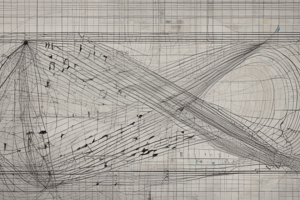Podcast
Questions and Answers
What is the Distributive Property?
What is the Distributive Property?
- When a value is added to every term inside a group
- When a value is divided by every term inside a group
- When a value is multiplied by every term inside a group (correct)
- When a value is subtracted from every term inside a group
Any value multiplied by zero automatically equals zero.
Any value multiplied by zero automatically equals zero.
True (A)
What is Absolute Value?
What is Absolute Value?
The distance a number is from zero.
When multiplying or dividing an inequality by a negative number, the inequality symbol flips.
When multiplying or dividing an inequality by a negative number, the inequality symbol flips.
What is 'Intercept' in graphing?
What is 'Intercept' in graphing?
What defines a function?
What defines a function?
What is the Domain in mathematics?
What is the Domain in mathematics?
What is the Range in mathematics?
What is the Range in mathematics?
What is the model equation for Direct Variation?
What is the model equation for Direct Variation?
The graph of Direct Variation always passes through the origin.
The graph of Direct Variation always passes through the origin.
What is the model equation for linear functions?
What is the model equation for linear functions?
What does Slope represent?
What does Slope represent?
What are Systems of Equations?
What are Systems of Equations?
What are Systems of Inequalities?
What are Systems of Inequalities?
Quadratic equations have the form ___
Quadratic equations have the form ___
What is the first step to solve a quadratic equation?
What is the first step to solve a quadratic equation?
What do synonyms for 'Solutions' refer to?
What do synonyms for 'Solutions' refer to?
What do you do with Exponents 'Side by Side' with the same base?
What do you do with Exponents 'Side by Side' with the same base?
What does 'Power to Power' mean regarding exponents?
What does 'Power to Power' mean regarding exponents?
Any term to the zero power automatically becomes one.
Any term to the zero power automatically becomes one.
What do Negative Exponents do?
What do Negative Exponents do?
What does the term 'Curve/Line Best Fit' refer to?
What does the term 'Curve/Line Best Fit' refer to?
What does 'Evaluate' mean in mathematics?
What does 'Evaluate' mean in mathematics?
How do you simplify Cube Roots?
How do you simplify Cube Roots?
Flashcards are hidden until you start studying
Study Notes
Algebra Terms and Properties
- Distributive Property involves multiplying a value by every term inside parentheses (think arrows).
- Zero Property states any value multiplied by zero equals zero.
- Absolute Value measures the distance from zero, always results in a non-negative number (e.g., |-2| = 2 and |2| = 2).
- When multiplying or dividing an inequality by a negative number, flip the inequality symbol.
Intercepts and Functions
- An intercept is the crossing point on a graph; use graphing tools to find intercepts by tracing.
- A function must have unique x-values (no repeats) and pass the Vertical Line Test.
Domain and Range
- Domain consists of all possible x-values (inputs or independent variables).
- Range encompasses all possible y-values (outputs or dependent variables).
Variation
- Direct Variation is represented by the equation Y = KX, where the graph passes through the origin. K can be any real number.
- Inverse Variation can use equations like Y = K / X or XY = K; its graph is a mirror image from the axes.
Linear Functions
- The equation Y = MX + B defines linear functions, where M is slope and B is y-intercept. The graph is always a straight line.
- Slope (M) also known as Rate of Change, is found by (change in Y) / (change in X).
Systems of Equations and Inequalities
- Systems of Equations involve two or more equations (e.g., 5x + 6y = 30). Solutions can be found graphically by locating intersections.
- Systems of Inequalities consist of two or more inequalities where the shaded region represents solutions; dashed lines indicate exclusions.
Quadratic Equations
- Quadratic equations have X squared as the highest exponent and graph as a parabola (U-shaped). The general form is Ax^2 + Bx + C = 0.
- To solve quadratic equations, factor them and set each factor to zero.
Terminology
- Solutions, roots, and x-intercepts all refer to points where the graph meets the x-axis.
Exponent Rules
- For multiplying exponents with the same base, add the exponents (e.g., X^4 * X^7 = X^11).
- "Power to Power" means to distribute the outer exponent to each inner exponent (e.g., (2x^3)^4 = 16x^12).
- Any term raised to the zero power equals one.
- For exponents with the same base in division, subtract the exponents.
- Negative exponents indicate a reciprocal (switch positions in fractions).
Best Fit Lines and Evaluation
- Determine if the data fits a line or curve by using regression methods in graphing tools (e.g., Linear Regression or Quadratic Regression).
- To evaluate expressions, find the value of variables by plugging in values, and the store feature on calculators can assist in this process.
Cube Roots
- Cube roots simplify similar to square roots, focusing on cube factors.
Studying That Suits You
Use AI to generate personalized quizzes and flashcards to suit your learning preferences.




